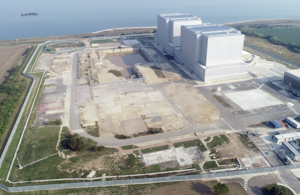Timing of the Magnox Reactor Decommissioning Strategy
The NDA has endorsed a site-specific approach to Magnox reactor decommissioning which will involve a mix of decommissioning strategies.

Bradwell in an interim state suitable for long-term deferral
The previous strategy for decommissioning Magnox reactor sites was developed over 30 years ago and involved deferring reactor decommissioning at all sites for approximately 85 years from reactor shutdown (SO42). In 2016, we committed to reviewing this strategy with Magnox Limited to take account of new experience and developments in the decommissioning landscape (ref 3).
Bradwell had previously been named as a lead site when the strategy was blanket deferral, and much of this new experience has come from placing Bradwell into an interim state suitable for long-term deferral. As well as developing innovative approaches to decommissioning (e.g. developing techniques to retrieve, condition and package ILW), the experience at Bradwell has improved our understanding of the costs and risks associated with preparing sites for deferral.
It has also demonstrated that some sites are unsuitable for longer periods of deferral. The work completed by Magnox Limited at Bradwell has helped to demonstrate that interim storage of waste in a dedicated facility is neither as complex nor as expensive as previously thought, albeit dependent on site-specific factors including the views of local stakeholders.
The review of the Magnox reactor decommissioning strategy (SO42) is now complete. We have concluded that whilst the deferred decommissioning strategy continues to have benefits in some cases, it is not appropriate as a blanket strategy for all reactors in the Magnox fleet because of their different design, location, age and physical condition. Consequently, the NDA has endorsed a site-specific approach to Magnox reactor decommissioning which will involve a mix of decommissioning strategies.
For some sites this will result in their decommissioning being brought forward whilst for others a deferral strategy with varying deferral periods will be the chosen approach. Magnox Limited will now prepare a business case (or cases), informed by local and national stakeholder views, for implementing this strategic change.
We have worked with both local and national stakeholders to identify factors from the NDA Value Framework (ref 17) that will discriminate between strategies for each site. This engagement has included discussion at the NDA Stakeholder Summit and various Site Stakeholder Group meetings, as well as strategy development groups involving government, regulators and local authorities. In November 2018 a large joint stakeholder event expressed the Value Framework factors as discriminatory questions (see table 2).
| Value Framework Factor | Discriminatory question |
|---|---|
| Health and safety Risk and hazard reduction | For each credible decommissioning strategy, what work (level of effort) is required to manage risks to people (workers and public)? |
| Environment | For each credible decommissioning strategy, what work (level of effort) is required to protect the environment? For each credible decommissioning strategy, what is the volume and nature of waste arising? |
| Socio-economic impact | To what extent does the community and local supply chain depend upon work at the site? What opportunities (value and likelihood) exist for alternative use of land at the site? How great is the visual impact of reactors? |
| Enabling the mission | What is the potential for reactor decommissioning to generate learning of relevance to other reactors? To what extent will reactor decommissioning allow the trial of new technologies or other strategic opportunities? |
| Lifetime cost | What work is required to prepare the reactors for deferral, and how much of this could be avoided by progressing with reactor dismantling? What opportunities exist for aligning decommissioning on neighbouring sites and what are the associated benefits? |
| Achievability (resources and logistics) | What capacity exists for interim storage of waste? Will interim storage of waste be problematic? How easy would it be to maintain or acquire a suitably qualified workforce after a period of deferral? |
Table 2: NDA Value Framework factors and their discriminatory questions
Magnox Limited has begun the process of selecting the optimum decommissioning strategy (SO42&43) for each of the Magnox reactors and, based on a review using factors listed above and in the NDA Value Framework (ref 17), Trawsfynydd has been chosen as a lead site for Magnox reactor decommissioning.
This is primarily because the external structure has degraded extensively since it was shutdown in 1991 such that substantial amounts of work would be required to make it safe for a long period of deferral; work that would then need to be undone to complete reactor dismantling. Furthermore, the site is located in Snowdonia National Park and in an area with a relatively weak local economy that is strongly dependent on work at the site.
The intention is that together the site-specific strategies will result in a rolling programme of activity as the Magnox fleet is decommissioned. This will maximise the opportunity for sharing any lessons learned, developing and implementing new technologies and strengthening wider capability. As a whole, the programme will collectively be geared towards reducing risk, reducing lifetime costs and growing skills and knowledge to deliver benefits both nationally and to local communities.
While we expect the new site-specific decommissioning strategies to be defined over the next 12 to 18 months, they will be continually reviewed and optimised using the learning obtained from the sites being decommissioned (SO42&43).
It is expected that the strategy for decommissioning Calder Hall (a former Magnox reactor on the Sellafield site) will also incorporate learning from the lead Magnox site, Trawsfynydd. The development of site-specific strategies at the Magnox reactor sites does not affect programmes at Harwell and Winfrith. Continued focus on safety and risk reduction will remain the overriding priorities across all the sites.